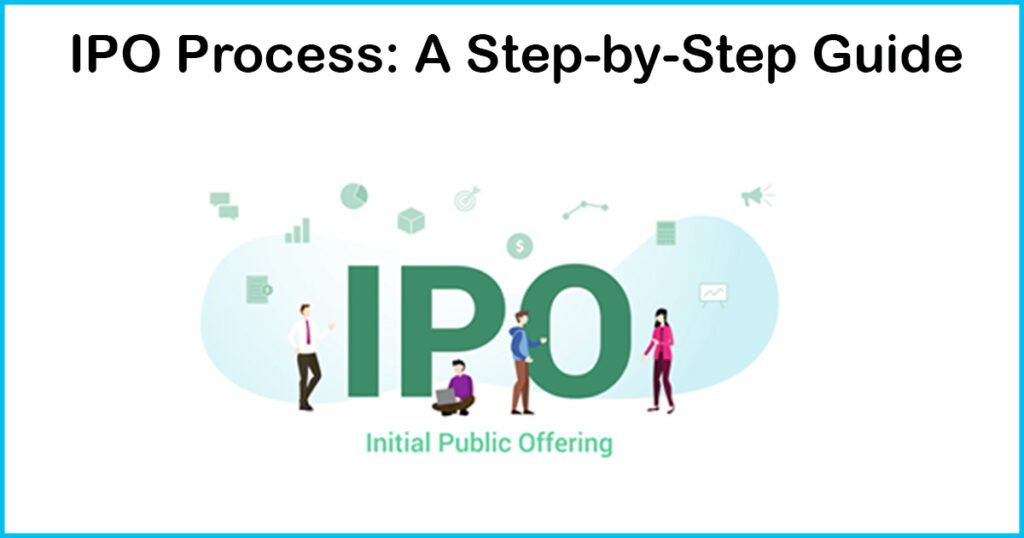The IPO process (Initial Public Offering) is a key step in a company’s development. An IPO is the first time that shares of a private firm are made available to the general public.
Understanding this IPO process is critical for both entrepreneurs and investors since it may determine the company’s future trajectory and affect the investment environment.
This step-by-step guide tries to demystify the IPO process by offering insights into the phases involved and the crucial decisions that must be taken.

What is an Initial Public Offering (IPO)?
An Initial Public Offering, or IPO, is the process through which a privately owned firm becomes a public corporation by issuing shares to the general public. This innovative step not only raises finances for the firm’s development but also allows investors to possess a piece in the company.
Preparing for an IPO
Before commencing the IPO journey, a thorough assessment of the company’s preparedness is required. This entails assessing the company’s financial soundness, performance data, and market competitiveness.
Choosing the proper underwriters and experts to help the firm through the difficulties of the IPO process is also critical.
Internally, rigorous compilation of financial accounts in compliance with auditing and accounting standards is critical.
This material will eventually serve as the foundation for the prospectus, a vital document that gives prospective investors with detailed information about the company’s financial health and activities.
Read More : IPO Allotment Tips – Increase Your IPO Allotment Chances
Due Diligence
As part of the IPO process, extensive due diligence is conducted by underwriters, legal teams, and financial experts.
The purpose of this thorough analysis is to check the correctness of the information supplied in the registration statement and to detect any potential liabilities or hazards associated with the company.
The due diligence procedure boosts investor trust and aids in the resolution of possible legal and financial difficulties following the IPO.
Roadshow and Investor Relations
Prior to the IPO, a roadshow is held to advertise the company’s shares to potential investors. This entails creating an entertaining presentation that showcases the company’s strengths, growth potential, and competitive advantages.
Key executives undergo training to effectively convey the company’s narrative and address investor queries. The roadshow enables the firm to establish investor connections, gauge demand, and ultimately determine the offering price for the shares..
Pricing and Allocation
Setting the IPO price is a vital choice that must strike a balance between the company’s desire to raise capital and the necessity to ensure a successful market debut.
The company and its underwriters work together to set an offering price that appropriately reflects the worth of the company.
Furthermore, selecting how to divide shares between institutional and individual investors is a difficult procedure that seeks to find a fair balance.
Going Public
On the day of the IPO, several activities and ceremonies celebrate the company’s shift from private to public ownership.
The company’s shares are made available for trading on a stock exchange, and the firm’s performance on the first day of trade is closely monitored.
This is the conclusion of months of planning and the start of the company’s public market journey.
Who Can Apply for an Initial Public Offering?
Participation in an IPO is open to a wide range of investors, including individuals, institutions, and even non-resident Indians (NRIs).
Each IPO might have specific criteria or limitations that potential investors need to consider, but in general, IPOs aim to attract a diverse pool of investors.
The Initial Public Offering (IPO) Process in India
The journey from a private entity to a publicly traded company involves several stages. Let’s explore the steps of the IPO process in India:
Step 1: Appointment of an Investment Bank
An investment bank is chosen to underwrite the IPO. They play a pivotal role in determining the offering price and structuring the IPO.
Step 2: Submission of Registration Forms to SEBI
The company files a draft prospectus with the Securities and Exchange Board of India (SEBI) for approval.
This document contains crucial information about the company’s financials, operations, and objectives.
Step 3: Red Herring Prospectus Submission
Once SEBI approves the draft prospectus, a red herring prospectus (a preliminary version of the prospectus) is filed with the Registrar of Companies. This document provides key details to potential investors.
Step 4: Advertising
Companies engage in marketing efforts to generate interest among potential investors. This may involve roadshows, advertisements, and presentations to showcase the investment opportunity.
Step 5: Setting the price
The company and the lead underwriter determine the final offer price through discussions. They take into account factors such as market conditions, industry trends, and company valuation.
Step 6: Listing and Refund
After setting the offer price, the company offers shares to the public. Once the subscription period concludes, the allocation of shares takes place, followed by the listing on the stock exchange. If the IPO is oversubscribed, the process of initiating refunds for excess funds commences.
How to invest in an IPO
Investing in an IPO involves a systematic approach.
- Research the company: Study the company’s financials, industry position, and growth prospects.
- Open a Demat Account: An essential requirement for trading in shares
- Apply for the IPO: Apply through ASBA (Application Supported by Blocked Amount) with your bank.
- Await Allotment: Once the IPO closes, wait for the shares to be allotted.
- Listing and Trading: If allotted, the shares will be credited to your Demat account and can be traded on the stock exchange.
Post-IPO Transition
Following the IPO, the firm will have increased reporting and compliance requirements. It is critical to adapt to these needs, maintain open communication with investors, and manage any stock price volatility.
Transitioning from a private to a publicly listed firm necessitates strategic planning and an emphasis on long-term sustainability.
Long-Term Implications
Becoming a publicly listed corporation has long-term consequences. Continuous compliance with regulatory requirements, balancing shareholder expectations, and managing the company’s reputation in the market are all ongoing issues.
Evaluating the long-term benefits of going public, such as improved financial availability and visibility, necessitates a strategic approach.
Case Studies and Lessons Learned
Real-world examples of successful initial public offerings (IPOs) provide significant insights into effective tactics and best practises.
Analysing cases where firms experienced obstacles or failures throughout the IPO process, on the other hand, aids in identifying traps to avoid.
Taking lessons from these case studies provides future IPO candidates with knowledge that can help them make decisions.
In conclusion, understanding Initial Public Offerings is crucial for both companies seeking expansion and investors seeking opportunities. The process outlined above illuminates the steps involved in transforming a private company into a publicly traded one, bridging the gap between companies’ funding needs and investors’ desire to participate in their growth journey.






